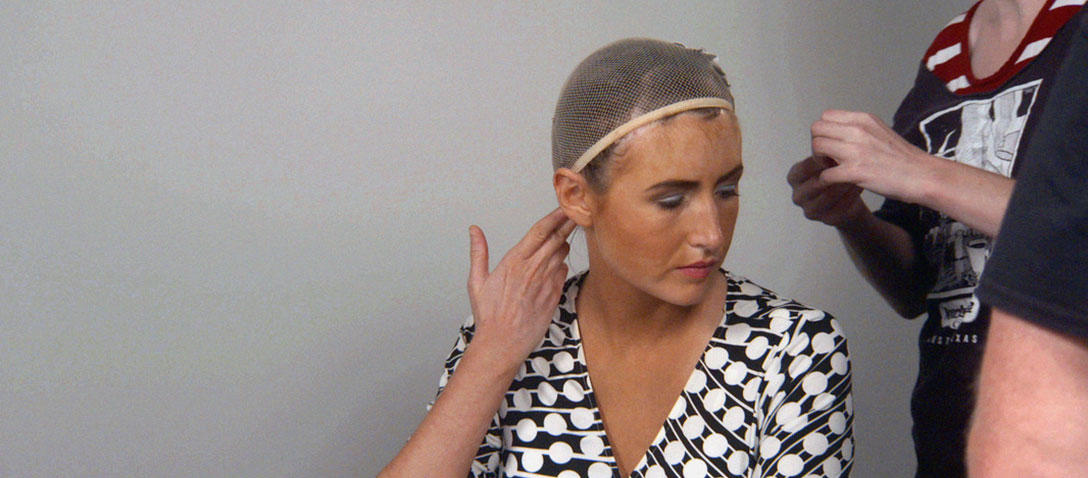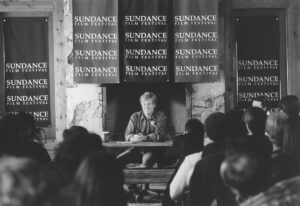Eric Hynes
After watching a film in which the lines between documentary and fiction, behavior and performance, reportage and speculation, are deliberately blurred, it was fitting that the discussion after the world premiere of Robert Greene’s Kate Plays Christine at the Temple Theater last night felt like a spillover from, or even a fulfillment of, the movie. In all respects, it was questions begging other questions, with on and off-screen lives and motivations and methods remaining meaningfully elusive.

The film stars actress Kate Lyn Sheil as herself and journeying with Greene’s documentary crew to Sarasota, Florida, to research the part of Christine Chubbuck, a TV newswoman who killed herself on air in 1974. Interviews with Sheil, local residents, and Chubbuck’s colleagues and friends are interspersed with stylized, soap opera-esque re-enactments of actual events in Chubbuck’s life.
When asked during the post-screening Q&A if there was ever a plan to actually make the fully dramatized version of Chubbuck’s life that’s mentioned and glimpsed in Kate Plays Christine, which screens as part of the U.S. Documentary Competition, Greene said that from the beginning the concept was to alternate between both formal modes within the same movie. “It’s not a very similar movie, but we’ve been comparing it to Day For Night, the Truffaut movie. It’s a film about the making of the film, but that’s not a separate product,” he said, flanked by Sheil, DP Sean Price Williams, and a host of producers, crew, and performers. “In fact all those scenes were based on the very limited materials we had,” regarding Chubbuck’s life, “and we were very strict about it. Almost all of the words spoken were what we knew to be spoken. We had to build that in. The idea would be that this film within a film is really just documentary reenactments.”
When asked if, after filming was over, there was any emotional carryover from having to inhabit the thoughts and feelings of a depressed and ultimately suicidal woman, Sheil acknowledged there was – to a point. Though the film depicts the actress’ arduous process of getting into character, where the character ends and the real person begins isn’t as clear as it might seem. “I think there’s always residue from every film that an actor does. It sticks with you for quite a while. Sometimes it’s almost imperceptible – you may find yourself feeling a certain way and then realize suddenly it had to do with the movie you had done a month ago. And I do still think about Christine Chubbuck quite a lot,” she said. “But also I was acting the entire time.”
When it came to filming the film’s final scene, Greene said they were uncertain as to how it would go right up until the last seconds of shooting, and that it was ultimately Sheil that defined what it would become. “We always knew it would end with something with the act itself,” he said referring to Chubbuck’s on-screen suicide. “But I didn’t know what that meant. Through the filming, as we gradually got closer and closer and learned more and more, it became harder to imagine going through with that scene. A few nights before when we were going to shoot it, I came up with my ideas, and at four in the morning another night Sean sent an email with his ideas of what it could be. But by that point Kate was in a zone. The whole thing took her to that place. So I had no idea what she was actually going to say. That tension, that hopefully you feel in the audience, was also intense for us.”
“Doing that was the most nerve-wracking thing I’ve ever shot,” Williams said. “It was like 15 minutes during which I was shaking, and Robert and I would look at each other – we just didn’t know. It was really up to her to make the final call about what was going to happen.” Greene agreed. “In that moment, Kate’s directing as much as anything. We’re along for the ride. And we’d all gotten there together. She took it where it needed to go.”
At that point Sundance Film Festival Senior Programmer David Courier stepped in to compliment Greene and his team for their open-ended approach, which is distinguishable from both narrative storytelling and traditional documentary. “In a straightforward fiction film, you have to make every decision. So if you’re playing Christine Chubbuck in a fiction film, you have to decide how she got to the point where she was going to kill herself, and you have to show it. What you guys are doing here is just saying – we don’t have the answers, and we’re trying to figure it out. And we get to witness the figuring out.”
“The film is about failure of understanding in some ways,” Greene said. “If you’re on the Internet for 5 seconds you know that everyone is so sure of their opinion. No matter what it is. But there are so few people saying, ‘Look, I don’t know how to say this, or how to talk about this.’ For me the whole documentary/fiction thing is so boring if it’s just ‘I can’t tell what’s real and what’s not.’ Hopefully with that last scene we found a way to take the real and the scripted and make it something new and different, push it further.”




